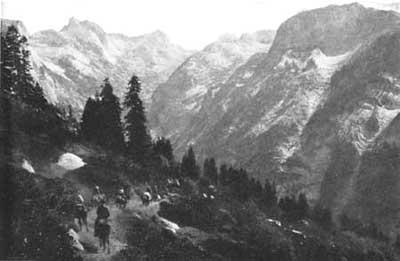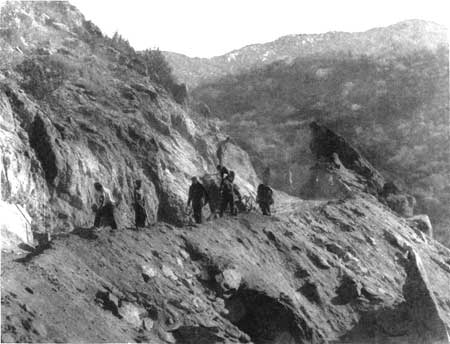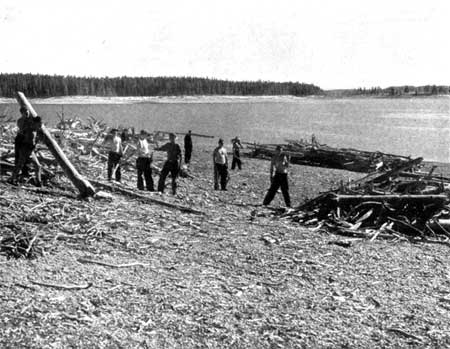MENU
![]() CCC
CCC
|
Glimpses of Our National Parks
THE NATIONAL PARKS AND THE CIVILIAN CONSERVATION CAMPS |
 On the trail—Sequoia National Park |
DEVELOPMENT of national park and monument trails of adequate fire protection facilities, and of campgrounds; protection of trees from spread of disease and infestation; clearing of roadsides for both fire prevention and esthetic reasons; rounding of slopes through cuts along the park highways to prevent slipping and erosion, and at the same time to beautify the highways—all these were dreams, sometimes even plans, toward which the National Park Service was working steadily before the spring of 1933. But the progress was slow, sometimes heartbreakingly difficult, because of financial limitations.
Then President Roosevelt announced his conservation program, a Director of Emergency Conservation Work was appointed, and the National Park Service was invited to participate by providing actual work for camps of the Civilian Conservation Corps and by active planning and correlation of the whole program through representation on the Advisory Council appointed to assist Director of Emergency Conservation Work.
Nothing approaching the scope of this work has ever been undertaken by any other government. Through these emergency conservation measures the development of the Nation's recreational areas—including State and metropolitan parks—has been advanced further than would have been possible in 10 to 20 years under the old order that prevailed prior to the spring of 1933. And the practical benefits from land development and the use thereof are increased immeasurably when one takes into consideration, the good done to the hundreds of thousands of young men given employment through this amazing conservation program; the salvage of social values through enabling these boys to regain and hold their selfrespect and to feel themselves an important part of the social fabric of our national life.
On July 1, 1940, it was the privilege of the National Park Service to supervise the work of approximately 310 Civilian Conservation Corps camps. Nearly one-third of these are upon national park, national monument, military park, or other areas directly administered by the Service. The remainder are upon State parks, metropolitan areas, and allied local parks. Responsibility for the work upon these latter areas was placed upon the National Park Service because State and similar park work is predicated upon the same premises as that for national parks, the purpose of all these areas being preservation of natural scenic beauty and historic shrines, and development for public use.

CCC men cutting a truck trail through granite ridge—Sequoia
National Park
Federal aid through Civilian Conservation Corps and emergency appropriations has encouraged widespread extension of State parks since 1933. Seven States have established their first State parks, and, with an increase of nearly 600 areas in 45 States, the total is now about 1,400. State park acreage, which prior to 1933 totaled 965,057, has been more than doubled.
Fortunately for the expedition of the work in national parks, the Service had prepared master plans based upon the 6-year development needs of these areas. With such plans, it was a simple matter to inaugurate work in the shortest possible time, without lost motion and without making the mistakes that might be expected to occur in putting into operation such a hastily conceived, hastily organized program of work.
The conservation activities directed by the National Park Service take the form of landscape protection rather than the straight forest protection that is the function of the Forest Service, which conserves the forest stands for use under wise regulation. All park work under the program necessarily is planned and conducted with detailed attention to the landscape values. Forest areas in those reservations are kept in their natural condition so far as possible. The removal of underbrush, dead trees, windfalls, and other natural debris from old forests is undertaken only to such an extent as is necessary to remove serious fire hazards. Ground cover is essential in the complete protection of bird life and small mammals, and also is part of the natural forest scene. Timber cutting is undertaken only when it is designed to improve the quality of young growth on cut-over or burned-over lands.
Although the work reports from the various parks show many millions of hours spent in roadside and trail clearing, forest-stand improvement, erosion control, and nursery work and seed collecting, it is always with the above principle in mind—to protect the landscape and to restore it to its primitive condition where scars have occurred through fire, tree disease, or necessary construction of roads and other facilities for visitors.
While landscape men supervise all plans for work by the Civilian Conservation Corps, other technical details also are given careful attention. Treatment of forest stands is under the supervision of expert foresters and work in historic areas in the military parks and monuments under the watchful eye of historians. Civil engineers see that all construction work is done on approved methods. What they are doing will make the great park system of the country a more valuable national asset.

Clean-up work at Jackson Lake by
CCC Enrollees—Grand Teton National Park
Certainly future visitors to the parks and monuments will get an added degree of enjoyment of the scenes they behold as a result of these conservation activities. It may even be that some of the magnificent tree stands will owe their continued existence to the present conservation activities against fire and various tree blights; that control of erosion along road sides may mean the salvation of other objects of beauty.
The young men who today constitute the Civilian Conservation Corps may well feel in the future special interest and ownership in the beauty spots of the country, which they have helped to preserve and make accessible to their fellow men. And it is the hope of the National Park Service that many men who first became acquainted with the parks through their participation in the Civilian Conservation Corps may find the activities so to their liking that they will continue to devote their energies to conservation. Certainly the interest taken in forestry and other conservation courses offered the Civilian Conservation Corps indicates a trend in this direction.
The National Park Service has expressed its approbation of the Civilian Conservation Corps activities in the strongest way possible—by expressing the hope that this work may be continued on a permanent basis. The wisdom with which the plan was conceived has been demonstrated by the splendid cooperation of the Government agencies engaged in carrying it out, the fine spirit of the enrollees, and the high quality of the work accomplished.
 Top
Top
Last Modified: Fri, Sep 1 2000 07:08:48 pm PDT
http://www.cr.nps.gov/history/online_books/glimpses1/glimpses2.htm
![]()

 II
II
